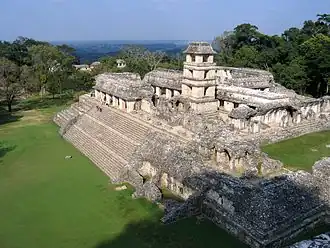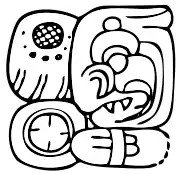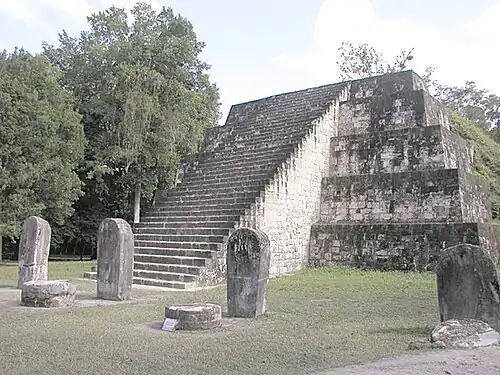Portal:Mesoamerica


 the Mesoamerica Portal
the Mesoamerica Portal _trim.png)
_trim.png)
_trim.png)

Mesoamerica (Spanish: Mesoamérica) is a region and cultural area in the Americas, extending approximately from central Mexico to Belize, Guatemala, El Salvador, Honduras, Nicaragua, and Costa Rica, within which a number of pre-Columbian societies flourished before the Spanish colonization of the Americas in the 15th and 16th centuries.
As a cultural area, Mesoamerica is defined by a mosaic of cultural traits developed and shared by its indigenous cultures. Beginning as early as 7000 BC, the domestication of maize, beans, squash and chili, as well as the turkey and dog, caused a transition from paleo-Indian hunter-gatherer tribal grouping to the organization of sedentary agricultural villages. In the subsequent formative period, agriculture and cultural traits such as a complex mythological and religious tradition, a vigesimal numeric system, and a complex calendric system, a tradition of ball playing, and a distinct architectural style, were diffused through the area. Also in this period villages began to become socially stratified and develop into chiefdoms with the development of large ceremonial centers, interconnected by a network of trade routes for the exchange of luxury goods such as obsidian, jade, cacao, cinnabar, Spondylus shells, hematite, and ceramics. While Mesoamerican civilization did know of the wheel and basic metallurgy, neither of these technologies became culturally important.
Among the earliest complex civilizations was the Olmec culture which inhabited the Gulf coast of Mexico. In the Preclassic period, complex urban polities began to develop among the Maya and the Zapotecs. During this period the first true Mesoamerican writing systems were developed in the Epi-Olmec and the Zapotec cultures, and the Mesoamerican writing tradition reached its height in the Classic Maya Hieroglyphic script. Mesoamerica is one of only five regions of the world where writing was independently developed. In Central Mexico, the height of the Classic period saw the ascendancy of the city of Teotihuacan, which formed a military and commercial empire whose political influence stretched south into the Maya area and northward. During the Epi-Classic period the Nahua peoples began moving south into Mesoamerica from the North. During the early post-Classic period Central Mexico was dominated by the Toltec culture, Oaxaca by the Mixtec, and the lowland Maya area had important centers at Chichén Itzá and Mayapán. Towards the end of the post-Classic period the Aztecs of Central Mexico built a tributary empire covering most of central Mesoamerica.
Selected article
.jpg)
El Tajín is a pre-Columbian archeological site and one of the largest and most important cities of the Classic era of Mesoamerica. A part of the Classic Veracruz culture, El Tajín flourished from 600 to 1200 C.E. and during this time numerous temples, palaces, ballcourts, and pyramids were built. From the time the city fell in 1230 to near the end of the 18th century, no European seems to have known of its existence, until a government inspector chanced upon the Pyramid of the Niches in 1785.
El Tajín was named a World Heritage site in 1992, due to its cultural importance and its architecture. This architecture includes the use of decorative niches and cement in forms unknown in the rest of Mesoamerica. Its best-known monument is the Pyramid of the Niches, but other important monuments include the Arroyo Group, the North and South Ballcourts and the palaces of Tajín Chico. In total there have been 17 ballcourts discovered at this site. Since the 1970s, El Tajin has been the most important archeological site in Veracruz for tourists, attracting over 650,000 visitors a year.
Selected biography

Ha' K'in Xook (Mayan pronunciation: [haʔ k’in ʃoːk]), also known as Ruler 6, was an ajaw of Piedras Negras, an ancient Maya settlement in Guatemala. He ruled during the Late Classic Period, from 767–780 AD. Ha' K'in Xook was a son of Itzam K'an Ahk II, and he ascended the throne upon the death of his brother, Yo'nal Ahk III. Ha' K'in Xook's reign seems to have ended either with his death or his abdication in favor of his brother K'inich Yat Ahk II, but archaeologists and Mayanists have not come to a clear consensus on this. Ha' K'in Xook left behind several monuments, including stelae at Piedras Negras and a stone fragment from El Porvenir. In addition, a stone seat known as Throne 1 which was erected by K'inich Yat Ahk II, records either the death or abdication of Ha' K'in Xook.
Did you know?

- ... that a new twin pyramid complex (east pyramid pictured) was built at the Maya city of Tikal every twenty years to celebrate the end of a Maya calendrical cycle?
- ... that at some Maya cities, the earliest production of stone stelae coincided with the establishment of dynastic rule?
Subcategories

Related portals
Selected image
Coatlicue, ([Cōhuātlīcue] Error: {{Langx}}: transliteration of latn script (help), is the Aztec goddess who gave birth to the moon, stars, and Huitzilopochtli, the god of the sun and war. She is also known as Toci (Tocî, "our grandmother") and Cihuacoatl (Cihuācōhuātl, "the lady of the serpent"), the patron of women who die in childbirth.
Featured articles
Good Topics
 Wikipedia:Good topics/Spanish conquest of the Maya
Wikipedia:Good topics/Spanish conquest of the Maya
Good articles
 Gómez de Alvarado
Gómez de Alvarado Aztecs
Aztecs La Blanca, Peten
La Blanca, Peten Calakmul
Calakmul Bartolomé de las Casas
Bartolomé de las Casas Copán
Copán El Chal
El Chal Haʼ Kʼin Xook
Haʼ Kʼin Xook History of chocolate
History of chocolate Itzam Kʼan Ahk II
Itzam Kʼan Ahk II Iximche
Iximche Kʼinich Yat Ahk II
Kʼinich Yat Ahk II Kʼinich Yoʼnal Ahk I
Kʼinich Yoʼnal Ahk I Macuahuitl
Macuahuitl Maize
Maize Manche Chʼol
Manche Chʼol Mixco Viejo
Mixco Viejo Motul de San José
Motul de San José Mundo Perdido, Tikal
Mundo Perdido, Tikal North Acropolis, Tikal
North Acropolis, Tikal Potbelly sculpture
Potbelly sculpture William H. Prescott
William H. Prescott Qʼumarkaj
Qʼumarkaj Resplendent quetzal
Resplendent quetzal Seibal
Seibal Serpent labret with articulated tongue
Serpent labret with articulated tongue Spanish conquest of Yucatán
Spanish conquest of Yucatán Spanish conquest of Chiapas
Spanish conquest of Chiapas Spanish conquest of El Salvador
Spanish conquest of El Salvador Spanish conquest of Honduras
Spanish conquest of Honduras Spanish conquest of the Maya
Spanish conquest of the Maya Tikal
Tikal Toniná
Toniná Western Mexico shaft tomb tradition
Western Mexico shaft tomb tradition Benjamin Lee Whorf
Benjamin Lee Whorf Yoʼnal Ahk III
Yoʼnal Ahk III Zaculeu
Zaculeu
Topics
WikiProjects

- History
- Mesoamerica
- Aztec task force
- Archaeology
- Mesoamerica
- Mexico
- Central America
- Belize
- El Salvador
- Guatemala
- Honduras
- Indigenous peoples of the Americas
Things to do
 |
Here are some tasks awaiting attention:
|
New articles
Rules | Match log | Results page (for watching) | Last updated: 2025-08-21 20:08 (UTC)
Note: The list display can now be customized by each user. See List display personalization for details.
- Itzel Astudillo (edit | talk | history | links | watch | logs | tools) by Zyanya0018 (talk · contribs · new pages (6)) started on 2025-08-20, score: 36
- Climate finance in Mexico (edit | talk | history | links | watch | logs | tools) by Charismad (talk · contribs · new pages (5)) started on 2025-08-20, score: 24
- Hendra Halim (edit | talk | history | links | watch | logs | tools) by Jeromi Mikhael (talk · contribs · new pages (22)) started on 2025-08-20, score: 32
- Profundulus kreiseri (edit | talk | history | links | watch | logs | tools) by Forkgator4641 (talk · contribs · new pages (7)) started on 2025-08-19, score: 28
- Brycon costaricensis (edit | talk | history | links | watch | logs | tools) by Quetzal1964 (talk · contribs · new pages (21)) started on 2025-08-19, score: 40
- Itaitubana alternata (edit | talk | history | links | watch | logs | tools) by B33tleMania12 (talk · contribs · new pages (1221)) started on 2025-08-19, score: 36
- Urostephanus (edit | talk | history | links | watch | logs | tools) by Abductive (talk · contribs · new pages (37)) started on 2025-08-19, score: 24
- Gambusia yucatana (edit | talk | history | links | watch | logs | tools) by Gaiacoyote (talk · contribs · new pages (3)) started on 2025-08-17, score: 36
- Red Jaguar Throne (edit | talk | history | links | watch | logs | tools) by Juan g. regino (talk · contribs · new pages (1)) started on 2025-08-17, score: 102
- Mouton Grammar Library (edit | talk | history | links | watch | logs | tools) by Reiner Stoppok (talk · contribs · new pages (24)) started on 2025-08-15, score: 26
- Climate finance in Guatemala (edit | talk | history | links | watch | logs | tools) by Charismad (talk · contribs · new pages (5)) started on 2025-08-14, score: 52
- Malata mitis (edit | talk | history | links | watch | logs | tools) by B33tleMania12 (talk · contribs · new pages (1221)) started on 2025-08-12, score: 24
- Epilachna olivacea (edit | talk | history | links | watch | logs | tools) by B33tleMania12 (talk · contribs · new pages (1221)) started on 2025-08-11, score: 24
- Epilachna vincta (edit | talk | history | links | watch | logs | tools) by B33tleMania12 (talk · contribs · new pages (1221)) started on 2025-08-11, score: 32
- Irma Alicia Velásquez Nimatuj (edit | talk | history | links | watch | logs | tools) by Alsoriano97 (talk · contribs · new pages (9)) started on 2025-08-11, score: 58
- Epilachna mexicana (edit | talk | history | links | watch | logs | tools) by B33tleMania12 (talk · contribs · new pages (1221)) started on 2025-08-11, score: 40
- Epilachna pocohantae (edit | talk | history | links | watch | logs | tools) by B33tleMania12 (talk · contribs · new pages (1221)) started on 2025-08-11, score: 32
- Epilachna discincta (edit | talk | history | links | watch | logs | tools) by B33tleMania12 (talk · contribs · new pages (1221)) started on 2025-08-11, score: 24
- Sandra Domínguez (edit | talk | history | links | watch | logs | tools) by Animaliak (talk · contribs · new pages (7)) started on 2025-08-09, score: 42
- Neaporia dianne (edit | talk | history | links | watch | logs | tools) by B33tleMania12 (talk · contribs · new pages (1221)) started on 2025-08-08, score: 24
Associated Wikimedia
The following Wikimedia Foundation sister projects provide more on this subject:
-
Commons
Free media repository -
Wikibooks
Free textbooks and manuals -
Wikidata
Free knowledge base -
Wikinews
Free-content news -
Wikiquote
Collection of quotations -
Wikisource
Free-content library -
Wikiversity
Free learning tools -
Wiktionary
Dictionary and thesaurus
-
 List of all portals
List of all portals -

-

-

-

-

-

-

-

-

-
 Random portal
Random portal -
 WikiProject Portals
WikiProject Portals







